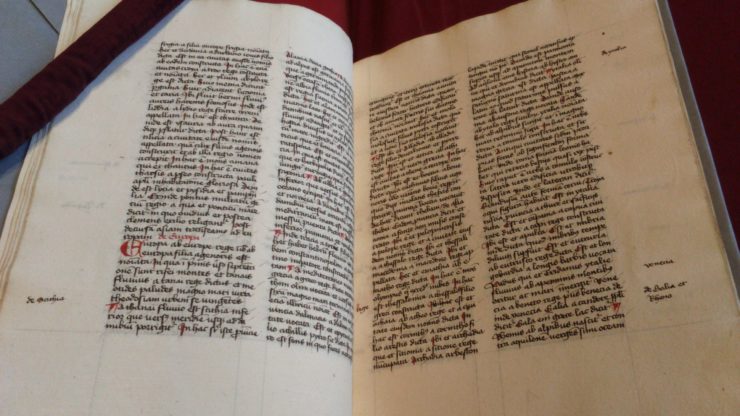Exhibition
Smaller books
Manuscripts containing the Imago mundi were produced well into the fifteenth century. Some contained only the text of the Imago mundi, but others reproduced it alongside other texts. The manuscript reproduced here with the kind permission of the Bibliothèque nationale de France is BnF n.a.l.1216 (s. xv). This manuscript contains two texts. As its first text (on folios 26-27r) it features a full copy of the Imago mundi (Books I-III). This is concluded with an address to the reader Rogo autem te lector. The second text is an anonymous Liber de descriptione terre sancte ‘Book of the description of the Holy Land’, which can be identified as the work of Buchard of Mount Sion, written ca. 1283. The pages on the photograph below show, towards the end of the first column, the beginning of the section of the text which describes Europe. Although we do not know for whom and under what circumstances this manuscript was made, we might surmise that this was someone interested in the religious aspects of geography and history.

BnF n.a.l. 1216 ff. 5v-6r
The image below shows the final page of the Imago mundi and the first page of the text following. Note that no attempt has been made to save space by adding the following text on the same page, a phenomenon more typical of earlier mansucripts, mostly written on costly vellum or parchment. Such economies were not as needed for paper manuscripts.

BnF n.a.l. 1216, ff. 27v-28r
For more on Buchard, whose text follows the Imago mundi in this manuscript, see Ingrid Baumgärtner, ‘Buchard of Mount Sion and the Holy Land’, Peregrinations: Journal of Medieval Art and Architecture 4.1 (2013), pp. 5-41.
To return to the exhibition entrance, click here.
To continue exploring the manuscript context of Imago mundi texts, click here.

